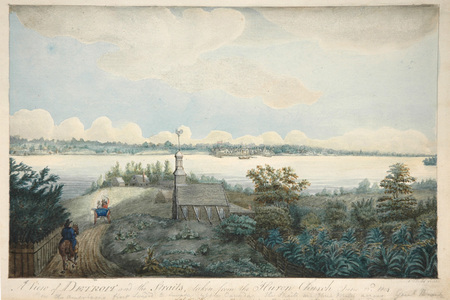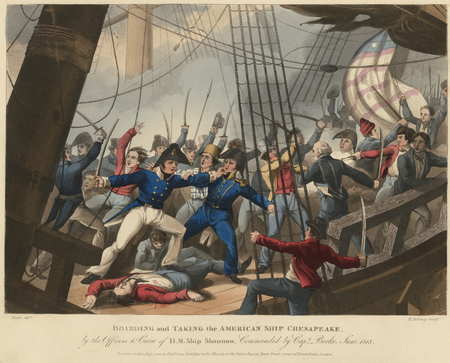Clements Library takes a bicentennial look at War of 1812

"A View of Detroit and the Straits, taken from the Huron Church on June 22nd 1804" By Edward Walsh
courtesy of the University of Michigan Clements Library
As the gallery statement in the University of Michigan William L. Clements Library pointedly says, “On June 18, 1812, the United States of America declared war on Great Britain, igniting a conflict that would continue for the next two and a half years. The opponents appeared wildly unmatched as the 36-year-old former British colony challenged a nation with the most powerful economy and navy in the world as well as a highly disciplined veteran army.”
War was declared for several reasons: the impressment of American merchant sailors into the Royal Navy was a central concern; British support of Native American Midwest tribes against American expansion was a second concern; and America’s desire to annex Canada was a third concern. All three of these issues are carefully covered in this display of original maps, manuscripts, and memorabilia.
As the Clements’ 16 display cases amply (and outstandingly) illustrate, the war was fought on eight differing fronts: the “old Northwest”; the Niagara Frontier; the St. Lawrence Valley; Lake Champlain; Atlantic coast blockades; Chesapeake Bay; the Gulf Coast; and the “High Seas.”
It’s now nearly an afterthought, but one of the most astonishing aspects of the war was the seemingly unfounded confidence America had in its willingness to enter into this conflict. After all, Great Britain was the world’s only superpower after the defeat of Napoleon in 1813.

"Boarding and Taking of the American Ship Chesapeake" by Charles Heath
courtesy of the University of Michigan Clements Library
Of particular interest in the Clements display is an 1813 colored copperplate engraving, “A View of Winchester in North America. Dedicated to Mr. President Mad I Son!” drawing on “a newspaper account of the battle of the River Raisin (at Frenchtown; present-day Monroe) ridiculing the capture of American General James Winchester by his Native American opponents.” As the Clements notes, a palm tree in the print was meant to identify the setting “as America.”
Even more interesting are artifacts sketching the sea war and Great Lakes war between American and Great Britain. Sketching the sea war are a 19th century bronze restrike “Commemorating (Commodore) William Bainbridge’s (1812) defeat of HMS Java” in a three-hour single-ship action against the USS Constitution (famed as “Old Ironsides)”; a “piece of wood from the flagship of Admirable Oliver Hazard Perry—Battle of Lake Erie” likely taken from the hull of Perry’s USS Niagara; and a bronze restrike commemorating Master Commandant Jesse D. Elliott’s controversial role in the Battle of Lake Erie.
Of additional interest in this display are a 1814 first edition print of Francis Scott Key’s “The Star Spangled Banner” written after Key witnessed the bombardment of Fort McHenry during the battle of Baltimore; Henry Clay’s Dec. 24, 1814 handwritten draft of “the Treaty of Ghent” signed, sealed, and later kept as a souvenir by British peace commissioner Henry Goulburn “after more formal copies had been executed”; and Samuel Seymour’s 1815 colored engraving of the “Battle of New Orleans” (from behind the American line) including “details that look as if they were recorded on the spot.”
Between these exceedingly rare artifacts and an 1814 Congressional Committee report “to Inquire into the Causes and Particulars of the Invasion of the City of Washington” detailing the “repairs and coats of white paint” that have now given the President’s residence it’s familiar nickname after getting torched by the British, there’s plenty to remember of this supposedly “forgotten” war.
It’s certainly more than enough of a remembrance to commemorate through the Clements’ remarkable permanent holdings two hundred years later.
“The War of 1812: A Bicentennial Exhibition” will continue through June 1 at the University of Michigan William L. Clements Library, 909 S. University Ave. Exhibit hours are 1-4:45 p.m. Monday-Friday. For information, call 734-764-2347.


Comments
Billy Bob Schwartz
Fri, May 11, 2012 : 9:35 p.m.
The Clements Library is an under-known gem in Ann Arbor. Their displays are often mind-blowing (well, at least for those of us who love American history). I can't wait to get a chance to visit and sink my mind into these items about Mr. Madison's War.